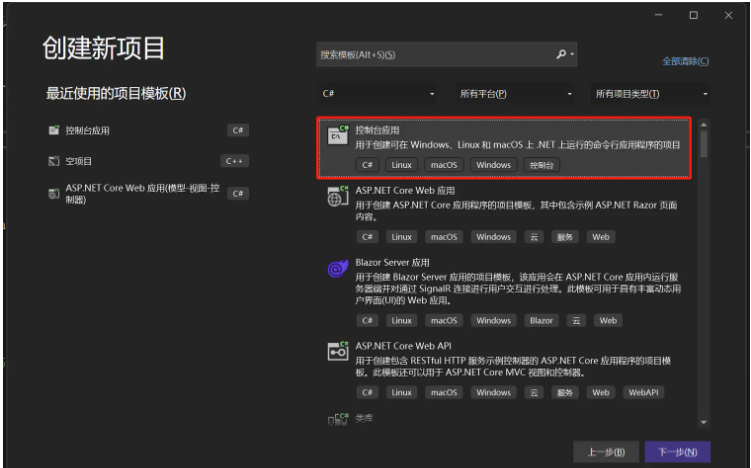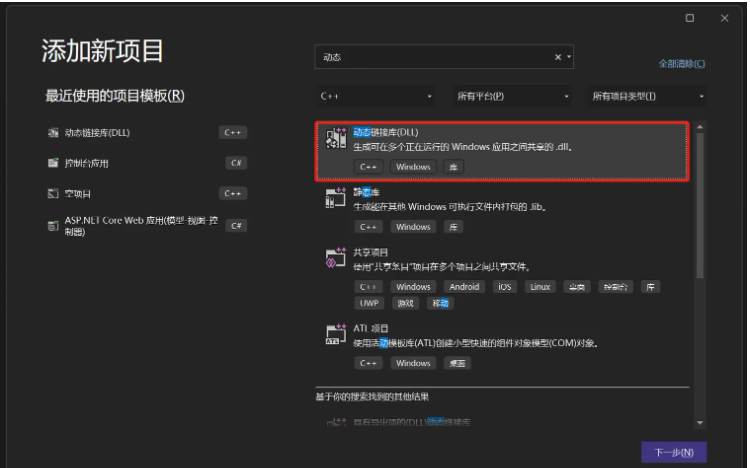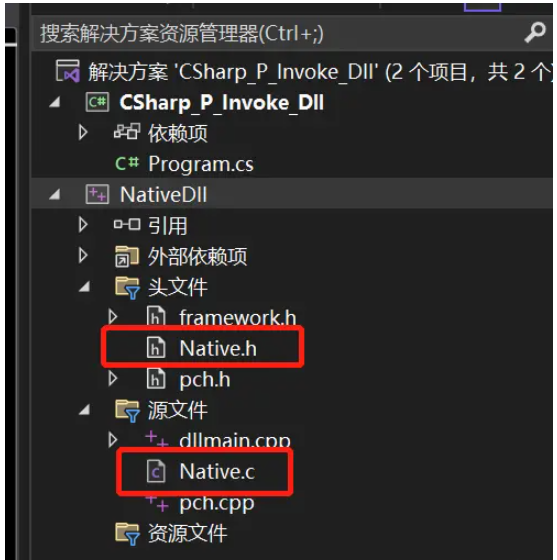您好,登錄后才能下訂單哦!
您好,登錄后才能下訂單哦!
這篇文章主要介紹了P/Invoke之C#調用動態鏈接庫DLL的方法是什么的相關知識,內容詳細易懂,操作簡單快捷,具有一定借鑒價值,相信大家閱讀完這篇P/Invoke之C#調用動態鏈接庫DLL的方法是什么文章都會有所收獲,下面我們一起來看看吧。
本編所涉及到的工具以及框架:
1、Visual Studio 2022
2、.net 6.0
P/Invoke全稱為Platform Invoke(平臺調用),其實際上就是一種函數調用機制,通過P/Invoke就可以實現調用非托管Dll中的函數。
在開始之前,我們首先需要了解C#中有關托管與非托管的區別
托管(Collocation),即在程序運行時會自動釋放內存;
非托管,即在程序運行時不會自動釋放內存。
打開VS2022,新建一個C#控制臺應用

右擊解決方案,添加一個新建項,新建一個"動態鏈接庫(DLL)",新建完之后需要右擊當前項目--> 屬性 --> C/C++ --> 預編譯頭 --> 選擇"不使用編譯頭"

在新建的DLL中我們新建一個頭文件,用于編寫我們的方法定義,然后再次新建一個C++文件,后綴以.c 結尾

在我們DLL中的頭文件(Native.h)中定義相關的Test方法,具體代碼如下:
#pragma once // 定義一些宏 #ifdef __cplusplus #define EXTERN extern "C" #else #define EXTERN #endif #define CallingConvention _cdecl // 判斷用戶是否有輸入,從而定義區分使用dllimport還是dllexport #ifdef DLL_IMPORT #define HEAD EXTERN __declspec(dllimport) #else #define HEAD EXTERN __declspec(dllexport) #endif HEAD int CallingConvention Sum(int a, int b);
之后需要去實現頭文件中的方法,在Native.c中實現,具體實現如下:
#include "Native.h" // 導入頭部文件
#include "stdio.h"
HEAD int Add(int a, int b)
{
return a+b;
}在這些步驟做完后,可以嘗試生成解決方案,檢查是否報錯,沒有報錯之后,將進入項目文件中,檢查是否生成DLL (../x64/Debug)

在這里之后,就可以在C#中去嘗試調用剛剛所聲明的方法,以便驗證是否調用DLL成功,其具體實現如下:
using System.Runtime.InteropServices;
class Program
{
[DllImport(@"C:\My_project\C#_Call_C\CSharp_P_Invoke_Dll\x64\Debug\NativeDll.dll")]
public static extern int Add(int a, int b);
public static void Main(string[] args)
{
int sum = Add(23, 45);
Console.WriteLine(sum);
Console.ReadKey();
}
}運行結果為:68,證明我們成功調用了DLL動態鏈庫
  通過上述一個簡單的例子,我們大致了解到了在C#中通過P/Invoke調用DLL動態鏈庫的流程,接下我們將對C#中的代碼塊做一些改動,便于維護
在改動中我們將用到NativeLibrary類中的一個方法,用于設置回調,解析從程序集進行的本機庫導入,并實現通過設置DLL的相對路徑進行加載,其方法如下:
public static void SetDllImportResolver (System.Reflection.Assembly assembly, System.Runtime.InteropServices.DllImportResolver resolver);
在使用這個方法前,先查看一下其參數
a、assembly: 主要是獲取包含當前正在執行的代碼的程序集(不過多講解)
b、resolber: 此參數是我們要注重實現的,我們可以通過查看他的元代碼,發現其實現的是一個委托,因此我們對其進行實現。
原始方法如下:
public delegate IntPtr DllImportResolver(string libraryName, Assembly assembly, DllImportSearchPath? searchPath);
實現resolver方法:
const string NativeLib = "NativeDll.dll";
static IntPtr DllImportResolver(string libraryName, Assembly assembly, DllImportSearchPath? searchPath)
{
string dll = Path.Combine(new DirectoryInfo(Environment.CurrentDirectory).Parent.Parent.Parent.Parent.ToString(), "x64","Release", "NativeDll.dll"); // 此處為Dll的路徑
//Console.WriteLine(dll);
return libraryName switch
{
NativeLib => NativeLibrary.Load(dll, assembly, searchPath),
_ => IntPtr.Zero
};
}該方法主要是用于區分在加載DLL時不一定只能是設置絕對路徑,也可以使用相對路徑對其加載,本區域代碼是通過使用委托去實現加載相對路徑對其DLL加載,這樣做的好處是,便于以后需要更改DLL的路徑時,只需要在這個方法中對其相對路徑進行修改即可。
更新C#中的代碼,其代碼如下:
using System.Reflection;
using System.Runtime.InteropServices;
class Program
{
const string NativeLib = "NativeDll.dll";
[DllImport(NativeLib)]
public static extern int Add(int a, int b);
static IntPtr DllImportResolver(string libraryName, Assembly assembly, DllImportSearchPath? searchPath)
{
string dll = Path.Combine(new DirectoryInfo(Environment.CurrentDirectory).Parent.Parent.Parent.Parent.ToString(), "x64","Release", "NativeDll.dll");
Console.WriteLine(dll);
return libraryName switch
{
NativeLib => NativeLibrary.Load(dll, assembly, searchPath),
_ => IntPtr.Zero
};
}
public static void Main(string[] args)
{
NativeLibrary.SetDllImportResolver(Assembly.GetExecutingAssembly(), DllImportResolver);
int sum = Add(23, 45);
Console.WriteLine(sum);
Console.ReadKey();
}
}最后重新編譯,檢查其是否能順利編譯通過,最終我們的到的結果為:68
  下面將通過一個具體實例,講述為什么要這樣做?(本實例通過從性能方面進行對比)
在DLL中的頭文件中,加入如下代碼:
HEAD void CBubbleSort(int* array, int length);
在.c文件中加入如下代碼:
HEAD void CBubbleSort(int* array, int length)
{
int temp = 0;
for (int i = 0; i < length; i++)
{
for (int j = i + 1; j < length; j++)
{
if (array[i] > array[j])
{
temp = array[i];
array[i] = array[j];
array[j] = temp;
}
}
}
}C#中的代碼修改:
using System.Diagnostics;
using System.Reflection;
using System.Runtime.InteropServices;
class Program
{
const string NativeLib = "NativeDll.dll";
[DllImport(NativeLib)]
public unsafe static extern void CBubbleSort(int* arr, int length);
static IntPtr DllImportResolver(string libraryName, Assembly assembly, DllImportSearchPath? searchPath)
{
string dll = Path.Combine(new DirectoryInfo(Environment.CurrentDirectory).Parent.Parent.Parent.Parent.ToString(), "x64", "Release", "NativeDll.dll");
//Console.WriteLine(dll);
return libraryName switch
{
NativeLib => NativeLibrary.Load(dll, assembly, searchPath),
_ => IntPtr.Zero
};
}
public unsafe static void Main(string[] args)
{
int num = 1000;
int[] arr = new int[num];
int[] cSharpResult = new int[num];
//隨機生成num數量個(0-10000)的數字
Random random = new Random();
for (int i = 0; i < arr.Length; i++)
{
arr[i] = random.Next(10000);
}
//利用冒泡排序對其數組進行排序
Stopwatch sw = Stopwatch.StartNew();
Array.Copy(arr, cSharpResult, arr.Length);
cSharpResult = BubbleSort(cSharpResult);
Console.WriteLine($"\n C#實現排序所耗時:{sw.ElapsedMilliseconds}ms\n");
// 調用Dll中的冒泡排序算法
NativeLibrary.SetDllImportResolver(Assembly.GetExecutingAssembly(), DllImportResolver);
fixed (int* ptr = &arr[0])
{
sw.Restart();
CBubbleSort(ptr, arr.Length);
}
Console.WriteLine($"\n C實現排序所耗時:{sw.ElapsedMilliseconds}ms");
Console.ReadKey();
}
//冒泡排序算法
public static int[] BubbleSort(int[] array)
{
int temp = 0;
for (int i = 0; i < array.Length; i++)
{
for (int j = i + 1; j < array.Length; j++)
{
if (array[i] > array[j])
{
temp = array[i];
array[i] = array[j];
array[j] = temp;
}
}
}
return array;
}
}執行結果:
C#實現排序所耗時: 130ms
C實現排序所耗時:3ms
關于“P/Invoke之C#調用動態鏈接庫DLL的方法是什么”這篇文章的內容就介紹到這里,感謝各位的閱讀!相信大家對“P/Invoke之C#調用動態鏈接庫DLL的方法是什么”知識都有一定的了解,大家如果還想學習更多知識,歡迎關注億速云行業資訊頻道。
免責聲明:本站發布的內容(圖片、視頻和文字)以原創、轉載和分享為主,文章觀點不代表本網站立場,如果涉及侵權請聯系站長郵箱:is@yisu.com進行舉報,并提供相關證據,一經查實,將立刻刪除涉嫌侵權內容。